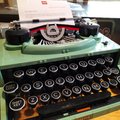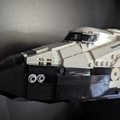Diabetes is hard, let's go shopping for a new glucose monitoring solution
Clarendon Room A | Thu 16 Mar 2:25 p.m.–3:10 p.m.
Presented by
-
 Lana has been playing with technology since the days when she lusted desperately after a Hypercolor t-shirt. She's no longer interested in the t-shirt, but the technology bit stuck, and she's now been working as a technical writer and manager for over fifteen years. A pedant since birth, Lana will quite happily lecture anyone for hours on the finer points of grammar, style, information architecture, and content strategy, if only people will stand still long enough. She recently had a mid-life crisis, which entailed buying an electric vehicle, kicking out her teenage daughter, and driving the car interstate to move in with her partner in Sydney. She still owns the cat and the Kitchenaid. The Roomba didn't make the cut.
Lana has been playing with technology since the days when she lusted desperately after a Hypercolor t-shirt. She's no longer interested in the t-shirt, but the technology bit stuck, and she's now been working as a technical writer and manager for over fifteen years. A pedant since birth, Lana will quite happily lecture anyone for hours on the finer points of grammar, style, information architecture, and content strategy, if only people will stand still long enough. She recently had a mid-life crisis, which entailed buying an electric vehicle, kicking out her teenage daughter, and driving the car interstate to move in with her partner in Sydney. She still owns the cat and the Kitchenaid. The Roomba didn't make the cut.
-
 Steve has been an open source developer for over 20 years, and first attended LCA in Brisbane, in 2002. Steve's first love was Perl, please don't hold that against him, but is currently deeply in love with Python. Steve had a financial crisis of his own just before the pandemic which involved buying property in Sydney as well as an electric vehicle. As such, Steve now has no money at all. Steve has also recently acquired a live-in girlfriend and a cat, which has put more of a strain on his non-existent finances.
Steve currently works for SUSE on packaging the Python interpreter, and all the way up the stack to Python leaf modules, as well as debugging test failures, module bugs and dealing with security issues.
Steve has been an open source developer for over 20 years, and first attended LCA in Brisbane, in 2002. Steve's first love was Perl, please don't hold that against him, but is currently deeply in love with Python. Steve had a financial crisis of his own just before the pandemic which involved buying property in Sydney as well as an electric vehicle. As such, Steve now has no money at all. Steve has also recently acquired a live-in girlfriend and a cat, which has put more of a strain on his non-existent finances.
Steve currently works for SUSE on packaging the Python interpreter, and all the way up the stack to Python leaf modules, as well as debugging test failures, module bugs and dealing with security issues.


Abstract
At its heart, keeping people with diabetes alive is all about data. When the trending glucose numbers go up, we need insulin. When the trending glucose numbers go down, we need sugar. All day, all night, for the rest of their lives. Thankfully, we live in 2023, and keeping track of trends in large amounts of time-series data is easy! Right?
Lana has been diabetic for 20 years, insulin-using for a decade, and now writes technical documentation about time-series data. Steve has been an open source developer for 20 years, and has an uncontrollable urge to solve every interesting problem he comes across. Together, they had an interesting data problem that they set out to investigate ... and hopefully improve. If they could make this better, it would make their lives better!
In this talk, Lana and Steve go through the different solutions Lana has tried over the years - from finger pricks, to continuous glucose sensors - and the trouble with accessing the data from each. Open source tools exist, the trouble is not usually with them, but with extracting the data from whatever patented tool has been used to collect it. They then talk about the current system, and how they use open source software to do things that the large pharmaceutical companies would really prefer we pay them to do for us.
If keeping Lana alive and well is all about accessing the time-series data generated by her own body ... why is it so hard?
YouTube: https://www.youtube.com/watch?v=rmR1EmSDK3Y
LA Archive: http://mirror.linux.org.au/pub/everythingopen/2023/clarendon_room_a/Thursday/Diabetes_is_hard_lets_go_shopping_for_a_new_glucose_monitoring_solution.webm
At its heart, keeping people with diabetes alive is all about data. When the trending glucose numbers go up, we need insulin. When the trending glucose numbers go down, we need sugar. All day, all night, for the rest of their lives. Thankfully, we live in 2023, and keeping track of trends in large amounts of time-series data is easy! Right? Lana has been diabetic for 20 years, insulin-using for a decade, and now writes technical documentation about time-series data. Steve has been an open source developer for 20 years, and has an uncontrollable urge to solve every interesting problem he comes across. Together, they had an interesting data problem that they set out to investigate ... and hopefully improve. If they could make this better, it would make their lives better! In this talk, Lana and Steve go through the different solutions Lana has tried over the years - from finger pricks, to continuous glucose sensors - and the trouble with accessing the data from each. Open source tools exist, the trouble is not usually with them, but with extracting the data from whatever patented tool has been used to collect it. They then talk about the current system, and how they use open source software to do things that the large pharmaceutical companies would really prefer we pay them to do for us. If keeping Lana alive and well is all about accessing the time-series data generated by her own body ... why is it so hard? YouTube: https://www.youtube.com/watch?v=rmR1EmSDK3Y LA Archive: http://mirror.linux.org.au/pub/everythingopen/2023/clarendon_room_a/Thursday/Diabetes_is_hard_lets_go_shopping_for_a_new_glucose_monitoring_solution.webm